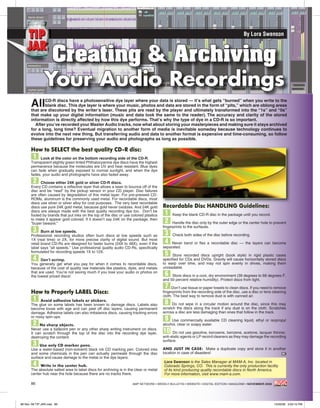
Archiving on CD-Rs
- 1. By Lora Swenson Creating & Archiving Your Audio Recordings Lora Swenson is the Sales Manager at MAM-A, Inc. located in Colorado Springs, CO. This is currently the only production facility of its kind producing quality recordable discs in North America. For more information, visit www.mam-a.com. 86 AMP NETWORK • WEEKLY BULLETIN • WEBSITE • DIGITAL EDITION • MAGAZINE • NOVEMBER 2008 AllCD-R discs have a photosensitive dye layer where your data is stored — it’s what gets “burned” when you write to the blank disc. This dye layer is where your music, photos and data are stored in the form of “pits,” which are oblong areas that are discolored by the writer’s laser. These pits are read by the player and ultimately transformed into the “1s” and “0s” that make up your digital information (music and data look the same to the reader). The accuracy and clarity of the stored information is directly affected by how this dye performs. That’s why the type of dye in a CD-R is so important. After you’ve recorded your Master Audio tracks, now what about storing your masterpieces and making sure it stays archived for a long, long time? Eventual migration to another form of media is inevitable someday because technology continues to evolve into the next new thing. But transferring audio and data to another format is expensive and time-consuming, so follow these guidelines for preserving your audio and photographs as long as possible. How to SELECT the best quality CD-R disc: 1 Look at the color on the bottom recording side of the CD-R. Transparent slightly green tinted Phthalocyanine dye discs have the highest permanence because the molecules are UV and heat resistant. Blue dyes can fade when gradually exposed to normal sunlight, and when the dye fades, your audio and photographs have also faded away. 2 Choose either 24K gold or silver CD-R discs. Every CD contains a reflective layer that allows a laser to bounce off of the disc and be “read” by the pickup sensor in your CD player. Disc failures are often caused by degradation of this metal layer. For pre-pressed CD- ROMs, aluminum is the commonly used metal. For recordable discs, most discs use silver or silver alloy for cost purposes. The very best recordable discs use pure 24K gold metal, because gold never oxidizes. And 24K gold discs are always made with the best quality recording dye too. Don’t be fooled by brands that put inks on the top of the disc or use colored plastics to make it appear gold colored. If it doesn’t say 24K on the package, then “buyer beware.” 3 Burn at low speeds. Professional recording studios often burn discs at low speeds such as 1X (real time) or 2X, for more precise clarity of digital sound. But most retail brand CD-Rs are designed for faster burns (24X to 48X), even if the label says “all speeds.” Use professional quality audio CD-Rs, specifically formulated for recording speeds 1X to 12X. 4 Don’t scrimp. You generally get what you pay for when it comes to recordable discs, because of the cost of quality raw materials like plastics, dyes, and metals that are used. You’re not saving much if you lose your audio or photos on the lowest priced discs! How to Properly LABEL Discs: 1 Avoid adhesive labels or stickers. The glue on some labels has been known to damage discs. Labels also become loose with age and can peel off disc layers, causing permanent damage. Adhesive labels can also imbalance discs, causing tracking errors or noisy spin-ups. 2 No sharp objects. Never use a ballpoint pen or any other sharp writing instrument on discs. It can scratch through the top of the disc into the recording dye layer, destroying the content. 3 Use only CD marker pens. Use a water-based (non-solvent) black ink CD marking pen. Colored inks and some chemicals in the pen can actually permeate through the disc surface and cause damage to the metal or the dye layers. 4 Write in the center hub. The absolute safest area to label discs for archiving is in the clear or metal center hub near the hole because there are no tracks there. Recordable Disc HANDLING Guidelines: 1 Keep the blank CD-R disc in the package until you record. 2 Handle the disc only by the outer edge or the center hole to prevent fingerprints to the surfaces. 3 Check both sides of the disc before recording. 4 Never bend or flex a recordable disc –– the layers can become separated. 5 Store recorded discs upright (book style) in rigid plastic cases specified for CDs and DVDs. Gravity will cause horizontally stored discs to warp over time, and may not spin evenly in drives, making them unreadable. 6 Store discs in a cool, dry environment (39 degrees to 68 degrees F, and 50 percent relative humidity). Protect discs from light. 7 Don’t use tissue or paper towels to clean discs. If you need to remove fingerprints from the recording side of the disc, use a disc or lens cleaning cloth. The best way to remove dust is with canned air. 8 Do not wipe in a circular motion around the disc, since this may scratch the discs along the track if any dust is on the cloth. Scratches across a disc are less damaging than ones that follow in the track. 9 Use commercially available CD cleaning liquid, ethyl or isopropyl alcohol, clear or soapy water. 10 Do not use gasoline, kerosene, benzene, acetone, lacquer thinner, anti-static agents or LP record cleaners as they may damage the recording surface. AND JUST IN CASE: Make a duplicate copy and store it in another location in case of disasters! 86 Nov '08 TIP JAR.indd 86 10/20/08 3:00:15 PM
